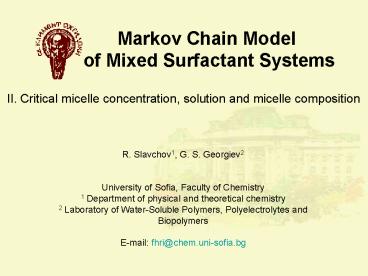Markov Chain Model PowerPoint PPT Presentation
1 / 31
Title: Markov Chain Model
1
Markov Chain Model of Mixed Surfactant Systems
II. Critical micelle concentration, solution and
micelle composition
R. Slavchov1, G. S. Georgiev2 University of
Sofia, Faculty of Chemistry 1 Department of
physical and theoretical chemistry 2 Laboratory
of Water-Soluble Polymers, Polyelectrolytes and
Biopolymers E-mail fhri_at_chem.uni-sofia.bg
2
The model
Micellization as a Markov chain process. Solution
of a single surfactant S1
Monomer in the solution
K11
S1 S1 S1S1
Micelle active center
Dyad active center
S1 S1S1
3
The model
Micellization as a Markov chain process. Solution
of two surfactants S1 and S2
Kii
S1 S1 S1S1
K12
S1 S2 S1S2
K21
S2 S1 S2S1
K22
S2 S2 S2S2
4
The model
Candidates for active centers
Linear aggregates
S2
S1
S1
S2S2
In the micelle molar part
In the solution monomer concentration molar part
c S1 S2
5
The model
Candidates for active centers
Disc-shaped micelles
In the micelle molar part
In the solution monomer concentration molar part
c S1 S2
6
The model
Candidates for active centers
In the micelle molar part
In the solution monomer concentration molar part
c S1 S2
7
The results
Solution of two surfactants S1 and S2
S1 S1 S1S1
S1 S2 S1S2
S2 S1 S2S1
S2 S2 S2S2
8
The results
Solution of two surfactants the c(x) dependence
Only one parameter
9
The results
Solution of two surfactants the y(x) dependence
Conditional probabilities for alteration/conservat
ion of the active centers
A second parameter needed for y(x)
10
The results
Solution of two surfactants closing the system
At given total concentration C with total
composition X1there are 3 unknown quantities c,
x1, y1
The mass balance
11
Relation to RS model
Regular solution model as a special case of MC
Markov chain
Regular solution
The c(x) dependencies are approximately equal when
The y(x) dependencies are approximately equal
when additionally
12
Relation to RS model
RS as a special case of MC the c(x) dependence
Markov chain
bRS 2
c mM
Regular solution
bRS 1
bRS 0
bRS -1.5
bRS -10
x1
13
Relation to RS model
RS as a special case of MC the y(x) dependence
Markov chain
y1
Regular solution
bRS -10
bRS 1
x1
14
Relation to RS model
RS as a special case of MC the y(x) dependence
Markov chain
y1
Regular solution
bRS -1.5
bRS 2
x1
15
Analysis
c(x) at different g
The solution for c
Eventual extrema
16
Analysis
c(x) at different g
At g?0 (bg ? -8) full synergism case, c 0 at
any x1.
17
Analysis
c(x) at different g
c mM
g0.5
g0.01
x1
At 0 lt g lt 1 (bg lt 0) synergetic interactions, c
lt cid If gltcmc2/cmc1 a single minimum
(condition for synergism).
18
Analysis
c(x) at different g
c mM
g1
x1
At g1 (bg 0) ideal solution,
19
Analysis
c(x) at different g
c mM
g5
x1
At g gt 1 (bg gt 0) antagonistic interactions, c gt
cid If ggtcmc1/cmc2 a single maximum (condition
for antagonism).
20
Analysis
c(x) at different g
c mM
g20
x1
At g gt 1 (bg gt 0) antagonistic interactions, c gt
cid If ggtcmc1/cmc2 a single maximum (condition
for antagonism).
21
Analysis
c(x) at different g
c mM
.
x1
At g?8 (bg ? 8) immiscibility,
22
Comparison with experimental results for cmc(X)
standard deviations from the experiment
type (nonionic/ionic/zwiterionic)
whichs better
23
Comparison with experimental results for cmc(X)
Results 6 wins for regular solution model5
wins for Markov chain model In average, Markov
chain is fitting cmc with 0.2 better Models
are describing cmc(X) equally well
24
Comparison with experimental results for y(x)
cmc(X) data determination of g and b
Results One parametric models cannot describe
both cmc(X) and y(x) in most cases. Markov
model can.
y(x) data determination of K12
25
Example with mixture of C8E5 and C8TAB
DErrico et al., PCCP, 2002
experimental data
cmc mm
MC model
y1
RS model
1 par. MC
x1
x1
g0.44
K129.39 mm-1
26
Example with mixture of C8E5 and C8TAB
DErrico et al., PCCP, 2002
The mass balance
27
Example with mixture of C8E5 and C8TAB
DErrico et al., PCCP, 2002
y1, x1
extrapolation for y(cmc)?
y1(C)
X10.15
x1(C)
C mm
28
Analysis
c(Cgtgtcmc)
c mM
Behavior with increasing the total concentration
C
cmc(X1)
g22 (bRS 2) K12 1 mM-1 X10.25
x1
y1
c in antagonistic systems can exhibit a maximum
y1 X1
x1(Cgtgtcmc)
x1
29
Analysis
x1, y1
x1
Behavior with increasing the total concentration
C
X1
g22 (bRS 2) K12 1 mM-1 X10.25
y1
C mM
c mM
This maximum can be at C much larger than
cmc. It is an alternative explanation of the
proposed by some authors second cmc.
C mM
30
Analysis
Behavior with increasing the total concentration
C Gharibi et al., 2000-2006
31
Summary
This study proposes an alternative to the
currently most used RS model for mixed
micellization. This new model is based on Markov
chain mechanism. Markov model - has one
fitting parameter for c(x) and one more for
y(x) - is leading to analytical functions for
both c(x) and y(x) - can be modified in one
parametric MC model, which is nearly equivalent
to RS for a large interval of bRS values -
describes cmc(X) data as good as RS -
describes y(x) data where RS fails - has A LOT
of unrealized capacity.
E-mail fhri_at_chem.uni-sofia.bg

